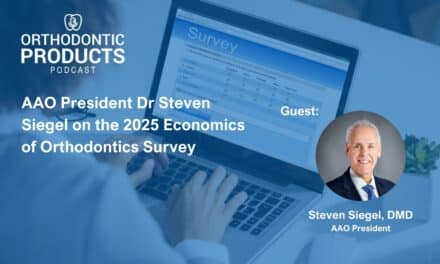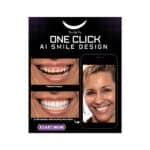Align Technology has recently begun more strictly enforcing its trademark and licensing agreements related to the use of the Invisalign brand in orthodontic marketing. For many practices, this has raised questions about what exactly is permitted and what needs to be removed or revised in their digital and print materials. In this episode, Alison Werner talks with orthodontic marketing expert Mary Kay Miller to clarify what this enforcement means in practice, what kinds of updates may be required to stay in compliance, and how orthodontists can protect their online visibility while adhering to the rules.
Miller, CEO and owner of Kaleidoscope and a longtime authority on digital marketing in orthodontics, has worked with practices navigating this very issue. She outlines the recent increase in cease-and-desist letters from Align, the specific marketing elements that may be in violation, and how practices can clean up their materials efficiently. Whether you’re currently offering Invisalign, plan to offer it again in the future, or are using alternative clear aligner brands, this episode provides essential guidance to avoid legal risk and SEO penalties.
What We Discuss:
- Why Align Technology is enforcing trademark rules more aggressively: In 2024, Align Technology took legal action against an orthodontic practice involving misuse of the Invisalign name alongside a competing brand. The company has begun closely monitoring how its trademark is used and issuing detailed legal notices to practices in violation.
- Who can legally use Invisalign branding in their marketing: Only providers who have placed a qualifying number of Invisalign case orders in the current calendar quarter are permitted to use the brand name and associated marketing assets in any form—web, social, or print.
- What compliance requires: Removing Invisalign references isn’t just a content edit. It often involves reworking SEO metadata, alt text, URLs, digital ads, and embedded video content to fully remove trademarked terms.
- What’s exempt from trademark restrictions: Patient-generated reviews are not subject to these restrictions. If Invisalign is mentioned in a review, it can remain, and these reviews often support strong local search rankings.
- Best practices for startups and multi-aligner practices: Miller suggests separating each aligner brand into its own page under a “Clear Aligners” navigation tab to keep the practice transparent, compliant, and searchable for multiple product terms.
Key Takeaways:
- Only active Invisalign providers may use the brand name in marketing.
- Full compliance requires more than editing a webpage—it includes SEO, URLs, and media.
- Patient reviews mentioning Invisalign are allowed and can enhance local SEO. OP
Chapters
00:00 Introduction to Invisalign Compliance
02:10 Understanding Trademark and Licensing Issues
05:52 Align Technology’s Legal Actions Explained
10:19 SEO Implications of Trademark Compliance
15:00 Best Practices for Orthodontic Practices
20:08 Advice for New Practices
23:22 Utilizing Reviews for SEO
Additional Resources
- Contact Mary Kay Miller at [email protected] or visit https://thekaleidoscope.com
- Check out the podcast: How Google’s AI Is Changing Online Visibility for Orthodontic Practices
Podcast Transcript
Alison Werner (00:05)
Hello and welcome to the orthodontic products podcast. I’m your host, Alison Werner. By now, most orthodontic practices know that Align technology is enforcing its trademark and licensing agreements more strictly than in the past, particularly regarding using the Invisalign keyword in digital marketing. As one of the most competitive and highly searched orthodontic terms, Invisalign presents opportunities and risks for practices.
But how do you stay compliant with their trademark and licensee agreements?
With me today is orthodontic marketing expert, Mary Kay Miller. She’s here to help us understand Align’s guidelines for digital marketing, print materials, and overall brand usage, and to explain what this means for the orthodontic practice. With over 40 years of experience in orthodontic marketing, Mary Kay is the CEO and owner of Kaleidoscope, a digital marketing agency specializing in the orthodontic industry.
Before founding Orthopreneur Internet Marketing in 2006, she spent 25 years as a business and marketing coordinator in private practice. Orthopreneur merged with Kaleidoscope in 2021, which expanded its services to help practices maximize online visibility. Kay is sought after speaker and she has lectured at major industry events, including the AAO and has contributed articles to many publications, including our own. Mary Kay, thanks for joining me again.
Mary Kay Miller (01:14)
Thank you for having me. And I really appreciate you giving me the opportunity to discuss this topic because I find there’s much misinformation around ⁓ practices on what really needs to be done and not need to be done. And I think it’s just a good opportunity to kind of get it all out in the open because there’s nothing complicated about this.
Alison Werner (01:37)
Yeah.
Mm-hmm.
Mary Kay Miller (01:41)
It’s
just understanding what you as a practice owner need to know when it comes to trademark, any type of trademark on your website and in your digital marketing. It’s just, you know, recently there, I have many doctors coming to me saying, you know, am I compliant with ⁓ the Invisalign trademark? And,
Alison Werner (01:52)
Yeah, absolutely.
Mary Kay Miller (02:04)
you know, since I actually have
Alison Werner (02:04)
Woof! Woof! Woof!
Mary Kay Miller (02:07)
practices that we had to address some of these issues,
And I actually have a letter from Align outlining exactly what needs to be done. You know, once you understand all this, it’s not that difficult to, you know, move forward with however you want to work with your aligner products in your practice.
Alison Werner (02:27)
Yeah. OK, so let’s talk about what prompted Align Technology to take legal action in it was May 2024.
Mary Kay Miller (02:31)
Thank
Well, there was a practice in Portland, Oregon that had misused the actual use of the trademark where, as you’re all aware, Invisalign has, shall we say, dumped hundreds of millions of dollars into their online marketing brand with the keyword Invisalign. It was trademarked in the late 1990s. And this trademark was put next to another clear aligner product.
Alison Werner (02:54)
Mm-hmm. Yeah.
Mm-hmm. ⁓
Mary Kay Miller (03:04)
so that when you put them back to back, it looked like that other aligner product was the Invisalign product, which was a total misuse of that trademark. ⁓ And the other thing has to do with the licensing agreement that each ⁓ individual practice owner has with Invisalign when they agreed to work with this product. They took their training. ⁓ Many doctors had done this many, many years ago.
Alison Werner (03:14)
Okay.
Mary Kay Miller (03:33)
So there were requirements on how many aligner packages or patients need to be purchased throughout the year to ⁓ be allowed to use the trademark assets. And we all know that, you know, there’s many, there’s a lot of ⁓ Invisalign trademark assets and they’re only to be used with the Invisalign product, not with any other clear aligner product. And this is where
Invisalign, it got its back up. I always say, you can poke the bear so many times. Invisalign has deep pockets. And they decided it was about time, since they’d lost their patent. And many, many clear aligner products are now out on the market, that they are going to protect their investment. So this is what this conversation is all about with this.
Alison Werner (04:19)
Yeah.
Mm-hmm.
Yeah.
Mary Kay Miller (04:28)
What I found surprising was, through the years, you know, I’ve been, you know, with a web agency since 2008, periodically, we would get a cease and desist order from Invisalign for one of our clients saying, we know that you are not providing the Invisalign product, please remove it from your website. I would notify the doctor. I would say, okay, we got to take, you know, the page down, you know, the written content and then, you know,
Alison Werner (04:46)
Mm-hmm. Mm-hmm.
Mary Kay Miller (04:59)
We had 30 days to do it and that was the end of it. But when this occurred, ⁓ we did in one instance receive a formal letter from Align legal specifically stating everything that need to be addressed with this client’s digital marketing. And what was surprising to me was the detail that they’re going into now. And you know,
Alison Werner (05:25)
Okay.
Mary Kay Miller (05:26)
they decided, okay, it’s not just a website. It’s all of your digital and print marketing. So what I wanna do is I would just like to read portions of this letter so that you hear directly from what it said so that in your own mind, you know exactly what it is ⁓ that they’re talking
Alison Werner (05:30)
Mm-hmm.
Okay.
Yeah, go ahead.
Mary Kay Miller (05:48)
And ⁓ they worded it very politely.
Alison Werner (05:52)
Mm-hmm.
Mary Kay Miller (05:53)
⁓ And it said, Align makes significant investments in promoting the well-known Invisalign brand, thereby boosting consumer recognition and visibility for authorized Invisalign providers, keyword being authorized, like yourself, helping to set you apart as a provider of a top-notch cutting edge treatment.
Align understands that you work hard to provide the products and treatments you believe are best for your patients. Our goal is to support you in pursuing your professional and clinical goals in a way that does not impair Align’s ability to protect and preserve the strength and integrity of the Invisalign and Align brands for the benefit of the Align family, for those practitioners that do offer the product.
Alison Werner (06:47)
Mm-hmm,
right.
Mary Kay Miller (06:50)
And what they did is they went into specifics of exactly what this meant. Your use of Invisalign brand assets such as your website, social media accounts, creates the appearance that you are a provider of Invisalign products. According to our records, however, you have not ordered any Invisalign product within the past 12 months or longer.
Alison Werner (06:57)
Okay.
Hmm.
Okay.
Mary Kay Miller (07:19)
If you are no longer offering Invisalign products as a treatment option to patients, then you should not continue to use Invisalign brand assets to promote your practice. Align permits only its active customers who have ordered a new Invisalign treatment. Now, this is a lot of transfer. This is a specific new treatment within the current calendar quarter.
Alison Werner (07:39)
Mm-hmm. Mm-hmm.
Mary Kay Miller (07:49)
to use the Invisalign brand assets. Because your last order was more than 12 months, we are writing to request that you discontinue using Invisalign brand assets in promoting your dental practice and stop making any representation that you offer Invisalign products to your patients. So.
The following are a non-exhaustive examples of use of Invisalign brand assets that we need you to edit, remove, or stop distributing. Any reference to Invisalign on the website, social media accounts such as Facebook, Instagram, TikTok, marketing materials, or collateral that may be displayed or provided to patients
in your office. Obviously these are your print materials. ⁓
Alison Werner (08:46)
Right.
Mary Kay Miller (08:51)
Internet advertising.
You can’t put Invisalign in your ads. Any URLs on the website. So if you take the written content off the page and you have it up in the URL, have to totally redo the URLs and business descriptions in the internet search engines. This has to do with the meta tags and the alt tags on the websites.
Alison Werner (08:57)
Mm-hmm.
Right? Yeah.
Huh.
Right.
Mary Kay Miller (09:20)
And ⁓ your Google My Business profile area, Yelp, Bing, any similar listings that reference the Invisalign name. ⁓ It also included video. If there’s any reference to personalized video, the video would need to be removed. So basically, they covered everything. They were very specific and very polite. ⁓
Alison Werner (09:25)
Mm-hmm.
⁓ okay.
Yeah. Yeah.
Mm-hmm.
Mary Kay Miller (09:50)
They wanted to do this, ⁓ but they, you know, were quite clear that they were watching and that this needed to be done. And we did do it. Now, what many practices are aware of for us to completely clean this up, we had to redo all the SEO on the site. We had to review all the written contents, the meta tags, the URLs, because Kaleidoscope is known for its SEO. And this was
Alison Werner (09:52)
Mm-hmm.
Yeah. Yeah.
Mm-hmm.
Okay.
Mm-hmm.
Mary Kay Miller (10:20)
This particular practice was ranking in the top three in a major metro area. This took anywhere from 12 to 15 hours of work to clean all this up. We had to watch video and the doctors just said, want to make sure it’s done right. We want your team, you go through and you clean it all
Alison Werner (10:24)
⁓
Okay.
Mm-hmm.
Mary Kay Miller (10:42)
The one area that Invisalign cannot request that you
Alison Werner (10:41)
Yeah.
Mary Kay Miller (10:49)
remove
keyword is the reviews area.
Alison Werner (10:50)
Woof! Woof! Woof! Woof!
Mary Kay Miller (10:54)
if a patient was writing a review and mentioned the keyword Invisalign, you can’t ask a patient to go in and take that review down. And what we found after we cleaned this all up was because there were so many references to the keyword Invisalign in this practice reviews, they had over 500 reviews.
Alison Werner (11:14)
Yeah.
Right.
Mary Kay Miller (11:17)
It did not affect them at all for that keyword in the map area. Now, the website did drop. I expected it to drop from page one to page three, but I was surprised to see that it still kept its ranking at the top of page two for the keyword Invisalign. And a lot of this has to do with Google now understands that, you know,
Alison Werner (11:22)
Okay.
Okay.
Mm-hmm.
Mm-hmm.
Mary Kay Miller (11:43)
Invisalign is a clear aligner product, but if someone specifically puts that keyword in there, then it will look for the keyword Invisalign first before it goes to the lesser practices using clear aligners. However, this particular client had been in practice for years and it had, even with clear aligners, there was good SEO now for clear aligners because we added it. They were able to
Alison Werner (11:45)
Mm-hmm.
Mm-hmm.
okay.
Mm-hmm.
Yeah.
Mary Kay Miller (12:12)
maintain that ranking higher than we thought. Now it was on page two, which means for all intents and purposes, it’s invisible, but it wasn’t invisible in the map. Now, one of the things that we discuss with this client, and I think is of value to all doctors, if you are offering more than one Invisalign product, or excuse me, Clear Aligner product, ⁓
Alison Werner (12:14)
Okay.
Mm-hmm.
Okay.
More of the, right, okay.
Mary Kay Miller (12:38)
What you do is you separate them on the website and you have separate pages for the different aligner products that you offer. This particular client that received this order was not using any other product. It was not using Invisalign at all and they did not want to go back to using that product. At one time they were a top 1 % Invisalign provider.
Alison Werner (12:42)
Mm-hmm.
Okay.
Okay. Okay.
Mm-hmm.
Mary Kay Miller (13:04)
but I have many clients, some of them that are using three or four different type of aligner products. So what we do is we did not remove all the SEO from the site, but what we did is change the navigation. Instead of it saying Invisalign, we changed it to Clear Aligners and we created dropdown pages for the different aligner products, or we had an Invisalign page and then a separate page that said Clear Aligners.
And then we listed all the clear aligners on that particular page because when all was said and done, ⁓ consumers are not using the different types of clear aligner products name when searching. You know, Invisalign is the Kleenex of clear aligners. That’s the keyword they use. And it actually is the number one orthodontic keyword now. And it’s with ads.
Alison Werner (13:37)
Okay.
Mm-hmm.
Yeah.
Mm-hmm.
Mary Kay Miller (14:00)
It’s what it’s the most expensive dental keyword. know, everybody’s vying for that, you know, with their ads. But if you say, for example, are offering other products and you meet your licensing agreement with Invisalign and I suggest you call your rep or call Invisalign directly and say, what do I need to do to meet my licensing requirements to use the brand assets? Then.
Alison Werner (14:07)
Mm-hmm.
Mm-hmm.
Mary Kay Miller (14:30)
You can have your Invisalign page. You can have it on the home page of the website. You can have it in the meta tags and under the hood in the SEO. And also you clearly state that you offer more than one product. You know, it’s not a bait and switch anymore. You do, if they want Invisalign, they can have it. Or if they offer a different clear aligner product, that’s great. You know, this is not about which one is a better product or
Alison Werner (14:38)
Yeah.
Mm-hmm. Yeah.
Mm-hmm.
Mary Kay Miller (15:00)
you know, the unrest that’s occurred over the years, you know, with Invisalign and the orthodontic industry. This isn’t anything about that. This is about trademark infringement and they are protecting their brand assets.
Alison Werner (15:10)
Right.
And it’s very, it’s honestly very straightforward. It would be the same situation if you had an automobile company and you were using a different brand to represent another brand. Yeah, so.
Mary Kay Miller (15:22)
Exactly. you know
it is what it is and it’s very easy to resolve.
Alison Werner (15:26)
Yeah. Yes. But it does sound
like it’s not as easy as just going into the back end of your website and deleting the word off your homepage or it is a little more involved. A lot more involved.
Mary Kay Miller (15:39)
No, Any link
that used to go to that, you know, say for example, you know, with good on-site SEO, you’re linking to the Invisalign page throughout, you know, that link is going to break once the page is down. You know, what you need to do is go through and make sure, okay, now instead of Invisalign page, we have a clear aligner page and it’s linking correctly. All the meta tags, all the photography.
⁓ that’s on the website that was coded for the keyword Invisalign. That show an aligner if it says Invisalign, AI can find that. And, you know, it’s my opinion that Invisalign probably has AI bots out there looking. You know, and, you know, they can afford to do that. And they are going to protect their brand assets.
Alison Werner (16:11)
⁓ yeah.
Yeah. Yeah.
Yeah.
Yeah, absolutely. So what’s your advice to a practice that’s established and maybe set up their website a long time ago? How should they go through this process if they want to make sure they’re in the clear or if they have received any kind of notification? Where should they start?
Mary Kay Miller (16:33)
Thank
They should start with their webmaster. And what I have found is there are still many practices that aren’t even aware that this occurred. Plus, the other thing is it never occurred to them to notify their webmaster when they started adding new aligner products. ⁓ I had many clients that when we’re rebuilding the website for them after
Alison Werner (17:01)
Yeah.
Mm.
Mary Kay Miller (17:20)
four years or so, it’s time to get a new website. One of the first questions we asked them, are you offering any new products or services? And you’d be surprised, like,
yeah, we’re doing this, this, this, and this. No one ever
to keep their website up to date. wasn’t top of mind.
Alison Werner (17:35)
Mm, yeah.
Mary Kay Miller (17:38)
So it’s important that you keep up to date with this with your webmaster.
⁓ One of the biggest issues that we’re running into is if you have a web provider that is not familiar with the orthodontic industry or even that this is going on, know, oftentimes they will hire a local web vendor or a member of the family. And, you know, they’re looking at what are the top keywords and it says Invisalign and they’re throwing that on the website when that product is not being offered.
Alison Werner (17:54)
Mm-hmm.
Mary Kay Miller (18:11)
It can be a problem because you’re working with a vendor that is not familiar with your industry. So it’s important that you monitor that yourself. And ⁓ if you know that there’s content on there, if you can edit the website yourself, you can go through and you can actually change the written content on the page. But what most practitioners and their team, they don’t know how to edit the SEO.
Alison Werner (18:15)
Yeah, right.
Mm-hmm.
Mm-hmm
Yeah, exactly.
Mary Kay Miller (18:38)
and get it out from under the hood. And
that’s where AI comes in. And when they specifically said URLs, I mean, that’s how that web page template is developed. And if you can’t just change a URL and take Invisalign out of it, because it will cause a 404 error and that page will break. So it has to be done a specific way. You’ve got write new pages, you got to transfer history in order to
⁓ Do something whenever you create a page on the internet, you just can’t delete it because it causes errors. You know, it’s all indexed on Google. Google knows it’s there. You take it down. You got to account for it and send it somewhere else.
Alison Werner (19:15)
Right.
Yeah.
Okay, okay. And then for, let’s reiterate, for practices that are offering, are still offering Invisalign, but they’re also offering other brands, as long as they have the right number of cases, they can still use the Invisalign trademark.
Mary Kay Miller (19:40)
Yes. You know, I just always recommend you talk to your
rep ⁓ in case the requirements are different. You know, multiple locations, DSOs may have different requirements for the minimum number of amount of cases and an individual private practice. You know, that’s not something that we keep track of ourselves. I always defer to, you know,
the Invisalign rep and they will be happy to walk you through this process. And if you decide that you do want to start offering Invisalign again, the reps are very good about, you know, making it clear this is what is required. Like for example, this particular practice, they said if they opted to start offering Invisalign again, they could.
but they could not use the brand assets again until they were cleared. So they probably would make them wait the year timeline where they had to show, okay, how much you’re ordering in the next year before they could start using it again. You can’t start using it again immediately.
Alison Werner (20:45)
Right.
Yeah. Yeah.
Okay. Okay. What’s your advice to practices that are just getting started new practices as they kind of wade into this? Are there any best practices to kind of protect themselves as they’re trying to figure out what kind of what aligner brands they want to offer?
Mary Kay Miller (20:55)
Thank you.
Just be, just to understand that if you opt to go with one of the clear aligner brands, you do not want to be adding Invisalign on there. Now, you know, I would have to say it’s, you know, I specialize in startups and transitions and I would have to say it’s probably 70, 30, 70 % of the startups are still going with Invisalign and 30 % aren’t.
And, you know, we as a web agency explain everything to them, just like I’m explaining it here, just so that they’re aware and that should they decide in the future that ⁓ they do want to offer a different brand. And many of them are going to their own in-office brands, you know, they’re doing it themselves. You just have to be aware of the fact that you will not show up in search, especially with the startup.
⁓ and accept the fact that, ⁓ you know, it’s the other orthodontic keywords where practice it, where consumers will find you. And I find a lot of the younger startups, that’s one of the reasons they go with Invisalign is because they know that keyword is so important. And then they can make a decision down the road what, you know, brand that they’re most comfortable with.
Alison Werner (22:27)
Yeah.
Mary Kay Miller (22:34)
And you know, and I always tell doctors when you’re asking someone for review and they’re using a an Invisalign product, have them mention the keyword Invisalign in their reviews. Because believe it or not, when if you really look at the reviews when you’re
Alison Werner (22:48)
Mm-hmm.
Mary Kay Miller (22:56)
looking in a local area, the keyword that’s put in there, you’ll notice it’s highlighted in those reviews. So if they’re saying orthodontist or braces or Invisalign or adult orthodontics, those keywords that are in the reviews, that’s the reviews that shows. So I mean, there is a tied SEO and what’s actually written in those reviews. know, somebody that just goes in and clicks five star and doesn’t write anything, that is not
Alison Werner (22:57)
Mm-hmm.
Yeah.
Yeah.
Mary Kay Miller (23:22)
optimally how you would want to utilize your reviews process. You normally I recommend that you ask them to write two or three sentences and that, you know, if need be, you prompt them what kind of keywords you want put in there because it just helps. I mean, it’s just one of the strategies we use when we’re
Alison Werner (23:26)
Okay.
Mm-hmm.
Yeah, yeah, yeah, absolutely.
Mary Kay Miller (23:43)
you know, as an internet marketing consultant that, you know, doctors are aware of all the little nuances because all these different puzzle pieces fit together and it just makes for a better experience.
Alison Werner (23:46)
Yeah.
you
Yeah.
Yeah, absolutely. Absolutely. Well, Mary Kay, if anybody has more questions or is confused or overwhelmed, how can they get in touch with you?
Mary Kay Miller (24:06)
very easily. can ⁓ email me directly at mk.miller at thekaleidoscope.com or just go to our website, thekaleidoscope.com and ⁓ fill in the contact area. There you can write some notes in there and just say, you know, want to speak to Mary Kay or speak to anyone in the team. You know, my entire team is very well trained in SEO and all the different.
ins and outs of these different types of issues that we run into in orthodontics. you know, it’s only going to ⁓ be more prevalent as AI is going through here. And, you know, AI for Google, but, you know, I’m convinced that, you know, it’s AI for Invisalign too. They’re going around. And it’s not just orthodontists, it’s general dentists too. I mean, this is
Alison Werner (24:53)
It’s AI for a lot of things. No, it’s, yeah.
Mary Kay Miller (25:01)
You know, this is industry wide, you know, right? You know, as far as Align’s concerned, you know, it doesn’t matter if you’re an orthodontist, general dentist, periodontist or whatever, you know, if you misuse their trademark and they, you know, you’re at a, it comes before them, they’re going to choose whether or not they’re going to say something or not, you know, who knows if you’re going to get caught in it, but you know, it’s just better to be safe than sorry.
Alison Werner (25:04)
It’s beyond this industry, it is every industry.
Yeah. Yeah.
Yeah,
absolutely, absolutely. Well, thank you so much Mary Kay. I really appreciate it. And again, her contact information will be in the show notes if you need to reach out to her. Thanks again, Mary Kay.
Mary Kay Miller (25:39)
Okay.
Thanks,













